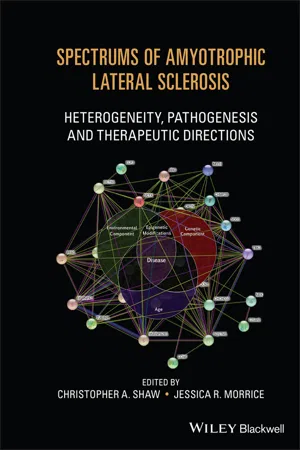
Spectrums of Amyotrophic Lateral Sclerosis
Heterogeneity, Pathogenesis and Therapeutic Directions
- English
- ePUB (mobile friendly)
- Available on iOS & Android
Spectrums of Amyotrophic Lateral Sclerosis
Heterogeneity, Pathogenesis and Therapeutic Directions
About This Book
SPECTRUMS OF AMYOTROPHIC LATERAL SCLEROSIS
Discover state-of-the-art research findings on ALS from leading authors and editors in the field
In Spectrums of Amyotrophic Lateral Sclerosis: Heterogeneity, Pathogenesis & Therapeutic Directions, distinguished researchers and editors Dr. Christopher A. Shaw and Jessica R. Morrice deliver a practical and powerful perspective on Amyotrophic Lateral Sclerosis (ALS) as a heterogeneous spectrum of disorders. This increasingly accepted point-of-view allows researchers and medical professionals to develop better targeted interventions and more precise therapies.
In the book, readers will find chapters on a wide variety of critical issues facing ALS researchers and healthcare practitioners treating ALS sufferers, including animal models of ALS, neuronal support cells known to have a pivotal role in ALS, and current challenges in ALS clinical trials, among others. The authors describe pathologic features common to all cases of ALS and why animal models, though crucial, should be interpreted with caution. Finally, multiple genetic and environmental etiologies of the disease are discussed.
Readers will also benefit from the inclusion of:
- A thorough introduction to ALS as a spectrum disease and the implications for models, therapeutic development and clinical trial design
- Explorations of the genetic basis of ALS, prospective sALS etiologies, and the involvement of microbiome in ALS
- Discussions of ALS-PDC and environmental risk factors, protein aggregation in ALS, defects in RNA metabolism in ALS, and the non-cell autonomous nature of ALS and the involvement of glial cells
- Examinations of animal models of ALS and perspectives on previously failed ALS therapeutics and current therapeutic strategies
Perfect for clinical neurologists, healthcare providers and caretakers, clinicians, and researchers studying motor neuron disease, Spectrums of Amyotrophic Lateral Sclerosis: Heterogeneity, Pathogenesis & Therapeutic Directions is also an indispensable resource for the neurodegenerative research community, neurology residents, and graduate-level neuroscience students.
Frequently asked questions
Information
CHAPTER 1
Clinical Heterogeneity of ALS – Implications for Models and Therapeutic Development
INTRODUCTION
Table of contents
- Cover
- Table of Contents
- Title Page
- Copyright Page
- Dedication Page
- Contributors
- Foreword
- Preface
- Acknowledgments
- CHAPTER 1: Clinical Heterogeneity of ALS – Implications for Models and Therapeutic Development
- CHAPTER 2: Genetic Basis of ALS
- CHAPTER 3: Susceptibility Genes and Epigenetics in Sporadic ALS
- CHAPTER 4: The Lessons of ALS‐PDC – Environmental Factors in ALS Etiology
- CHAPTER 5: The Microbiome of ALS – Does It Start from the Gut?
- CHAPTER 6: Protein Aggregation in Amyotrophic Lateral Sclerosis
- CHAPTER 7: Evidence for a Growing Involvement of Glia in Amyotrophic Lateral Sclerosis
- CHAPTER 8: Animal Models of ALS – Current and Future Perspectives
- CHAPTER 9: Clinical Trials in ALS – Current Challenges and Strategies for Future Directions
- CHAPTER 10: Future Priorities and Directions in ALS Research and Treatment
- Index
- End User License Agreement